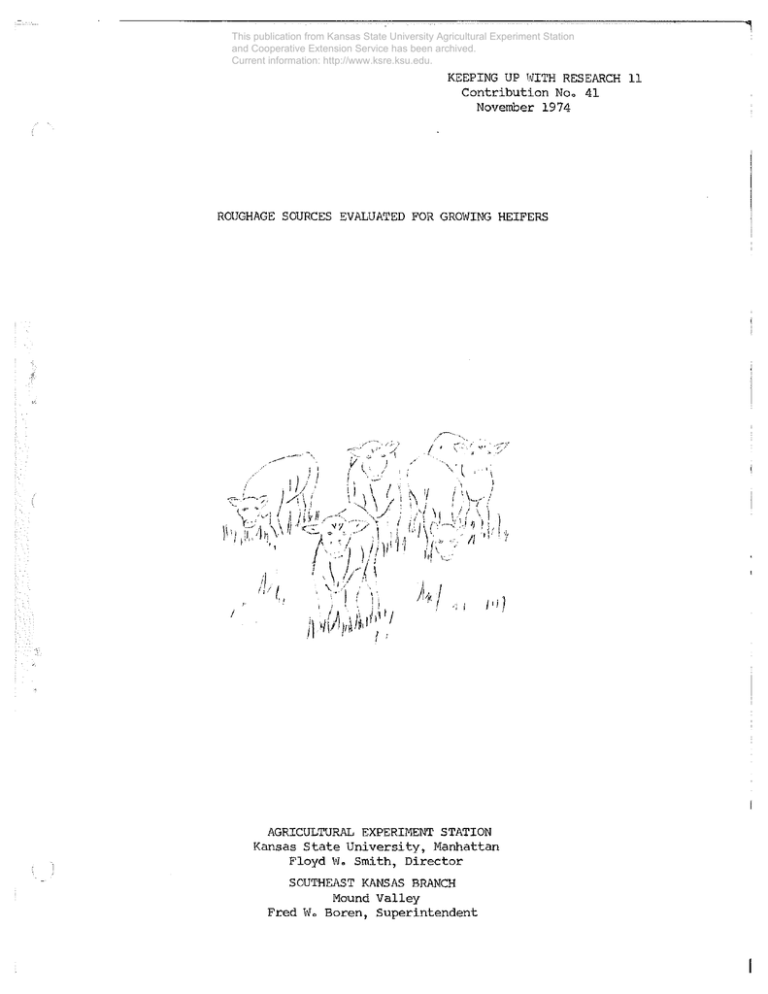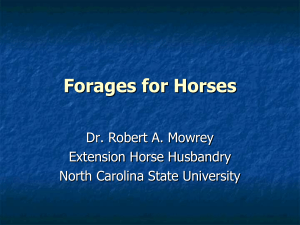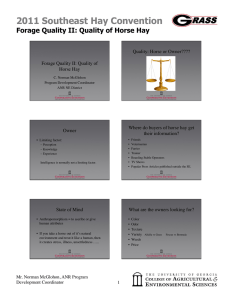This publication from Kansas State University Agricultural Experiment Station
advertisement

This publication from Kansas State University Agricultural Experiment Station
and Cooperative Extension Service has been archived.
Current information: http://www.ksre.ksu.edu.
KEEPING UP lrHTH RESEARCH 11
Contribution Noo 41
November 1974
ROUGHAGE SOURCES EVALUATED FOR GROWING HEIFERS
AGRICULTURAL EXPERIMENT STATION
Kansas State University, Manhattan
Floyd Wo Smith, Director
SOUTHEAST KANSAS BRANCH
Mound Valley
Fred Wo Boren, Superintendent
This publication from Kansas State University Agricultural Experiment Station
and Cooperative Extension Service has been archived.
Current information: http://www.ksre.ksu.edu.
Roughage Sources Evaluated for Growing Heifers
Leslie J. Chyba, Beef Scientist
Fred w. Boren, Station Superintendent
When roughages are a large percentage of the ration, as in growing
rations, roughage quality is important so less supplementary protein and
energy are needed. Sudangrass hay is a potential high yielder of high
quality hay.
We compared two sorghum x sudan crosses {Sudax ST6 and Pioneer 988)
and a hybrid sudangrass (Trudan V) with commonly used hay, bermudagrass,
and native grass. Fescue pasture was included because it often is grazed
fall and winter in southeastern Kansas with cattle OaFHthe heifers we
used.
Sudangrasses were cut when they reached 4 to.5 feet high. Bermudagrass was baled as it started to head, and native hay was baled when the
most tonnage of high quality hay could be harvested (July-August). Five
acres of Kentucky-31 fescue was overseeded into an established stand of
Midland bermudagrass (overseeded September 1972). Fifty pounds per acre
of actual nitrogen was applied before the cattle pastured.
Sixty head of Hereford and Angus heifers were equally divided by
weight among the six treatments. All hays were offered free-choice;
rolled milo and soybean oil meal were fed at 3.6 and 0.5 pounds,
respectively, per head daily to all cattle. Dicalcium phosphate and salt
were offered free-choice. Before starting the study, we injected each
calf with 1 million international units of Vitamin A.
Results
Heifers fed the two sorghum x sudan crosses (Sudax ST6 and Pioneer
988) gained faster (P<.05) and were more efficient than other heifers
did. The crosses contained 11.3-12.8% protein and may have not required
supplemental protein. Trudan V's larger, thicker stalk made a coarse
hay. Its crude protein content was considerably lower than the other two
sudan hays. Trudan V, bermudagrass hay, and fescue pasture produced
similar cattle gains. Cattle fed native hay were the least efficient
and had the poorest gains of any hay-fed group. Grazing fescue appears
to be a good alternative to drylot roughage feeding in terms of labor
requirements and animal performance. The supplementary energy and
protein needs of light weight cattle on fescue will be studied in the
near future.
With proper management sudangrass offers an excellent potential for
the production of high quality hay that can be used to reduce supplementary protein needs in a wintering program.
This publication from Kansas State University Agricultural Experiment Station
and Cooperative Extension Service has been archived.
Current information: http://www.ksre.ksu.edu.
Table lo Performance of heifers fed indicated sources of hay and
roughages during the winter of 1974 (January 23, 1974, to May 1, 1974 -99 days).
Item
Noo of animals
Initial wt., lbso
Final wto , lbs.
Wt. gain, lbs.
Avg. daily gain, lbs.
Sudax*
ST6 .
10
408.5
547.5
139.0
lo40a
Pioneer*
988
10
406.5
554.5
148.0
1.49a
Trudan*
v
10
403.0
519.5
116.5 b
lol8
Bermudagrass
Native Fescue••
hay
pasture
hay
10
399.5
405.0
508.5
483.0
103o5 b 83.5
.84c
1.05
D.Mo Daily Intake, lbso
Hay
Grain
Soybean meal
Feed/gain, lbso
Hay's crude protein, %
10
10
415.5
512.5
109.0 b
1.10
15.0
l0o9
3.6
.5
12.4
11 .. 6
l4o5
13.8
8.3
6.9
17.9
•
Sudax ST6 = sorghum x sudan cross; Pioneer 988 = sorghum x sudan cross;
Trudan V = hybrid sudangrass. Received 90 pounds actual nitrogen,
60 pounds 1< 0, and 90 pounds P o •
2
2 5
•• Overseeded aQ
established bermudagrass
sod September 1972. Received 50
pounds of actual N in September 1973.
a,b,c. Values on same line with different superscripts differ significantly
(P<.OS ).
Information in this report is for farmers, producers, colleagues,
industry cooperators, and other interested persons. It is not a recommendation or endorsement as it is not yet backed by enough research.
Contribution no. 41, Southeast Kansas Branch Experiment Station,
Mound Valley, Kansas Agricultural Experiment Station, Kansas State
University.
Publications and public meetings by the Kansas Agricultural Experiment Station are available and open to the public regardle ss of race ,
color, national origin, s ex, or religion.




